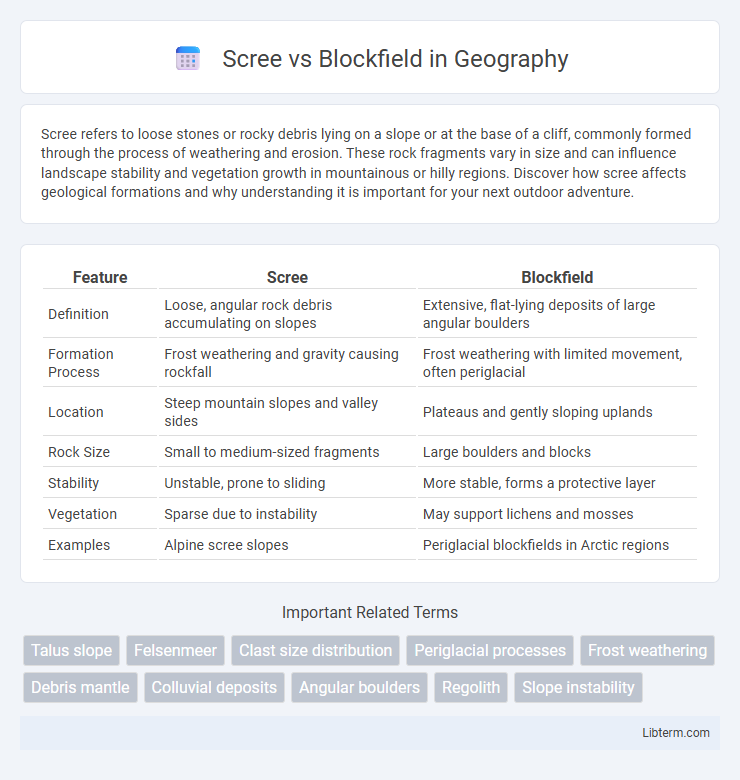Scree refers to loose stones or rocky debris lying on a slope or at the base of a cliff, commonly formed through the process of weathering and erosion. These rock fragments vary in size and can influence landscape stability and vegetation growth in mountainous or hilly regions. Discover how scree affects geological formations and why understanding it is important for your next outdoor adventure.
Table of Comparison
| Feature | Scree | Blockfield |
|---|---|---|
| Definition | Loose, angular rock debris accumulating on slopes | Extensive, flat-lying deposits of large angular boulders |
| Formation Process | Frost weathering and gravity causing rockfall | Frost weathering with limited movement, often periglacial |
| Location | Steep mountain slopes and valley sides | Plateaus and gently sloping uplands |
| Rock Size | Small to medium-sized fragments | Large boulders and blocks |
| Stability | Unstable, prone to sliding | More stable, forms a protective layer |
| Vegetation | Sparse due to instability | May support lichens and mosses |
| Examples | Alpine scree slopes | Periglacial blockfields in Arctic regions |
Introduction to Scree and Blockfield
Scree consists of loose, broken rock fragments that accumulate at the base of cliffs or steep slopes due to weathering and erosion processes. Blockfields, also known as felsenmeer, are extensive, flat or gently sloping surfaces covered by large, angular boulders typically formed by frost weathering in cold climates. Both landforms represent different types of rock debris distribution influenced by geological and climatic conditions.
Definition of Scree
Scree refers to a collection of loose, broken rock fragments accumulating at the base of cliffs or steep slopes, formed primarily by mechanical weathering processes such as freeze-thaw cycles. It is typically characterized by small to medium-sized angular stones that are unstable and prone to movement. In contrast, a blockfield consists of larger, more stable rock fragments that cover flat or gently sloping terrain, often resulting from prolonged frost weathering in periglacial environments.
Definition of Blockfield
A blockfield, also known as a felsenmeer, is an extensive surface covered by a layer of large, angular rock fragments typically formed through frost wedging in periglacial environments. In contrast, scree consists of smaller, more rounded rock debris that accumulates at the base of cliffs or slopes due to weathering and gravity. Blockfields are characterized by their immobility and extensive coverage on flat or gently sloping terrain, whereas scree slopes are dynamic and prone to movement.
Formation Processes of Scree
Scree forms through the mechanical weathering process called frost wedging, where water infiltrates cracks in rock, freezes, expands, and breaks the rock into angular fragments. This accumulation of broken rock fragments typically collects at the base of cliffs or steep slopes, creating a loose, unstable deposit. Unlike blockfields formed mainly by chemical weathering and freeze-thaw cycles in periglacial environments, scree deposits are primarily shaped by physical disintegration and gravity-driven movement.
Formation Processes of Blockfield
Blockfields form through prolonged freeze-thaw cycles in cold climates, where physical weathering breaks down bedrock into angular blocks without significant downslope movement. Unlike scree slopes, which accumulate from rockfall and accumulate in talus cones, blockfields remain relatively flat as the fragmented rock remains in place due to limited gravitational displacement. These periglacial environments foster frost shattering and minimal erosion, preserving the blocky surface characteristic of blockfields.
Key Differences Between Scree and Blockfield
Scree consists of loose, small rock fragments that accumulate at the base of cliffs or steep slopes, formed primarily through freeze-thaw weathering processes. Blockfields, in contrast, are extensive, flat or gently sloping areas covered by large, angular boulders resulting from long-term frost shattering in periglacial environments. The key differences lie in their formation, size of rock debris, and typical landscape settings: scree forms steep, unstable deposits below cliffs, while blockfields create stable, expansive surfaces on gentle terrain.
Geographical Distribution of Scree and Blockfield
Scree typically forms on steep mountain slopes worldwide, especially in regions with active frost weathering such as the European Alps, Rocky Mountains, and Himalayas. Blockfields, also known as felsenmeers, primarily occur in high-latitude or high-altitude areas with cold climates, including Scandinavia, Scotland, and parts of the Arctic and subarctic zones. The geographical distribution of scree is associated with dynamic slope processes, whereas blockfields develop in areas with prolonged freeze-thaw cycles and limited slope movement.
Ecological Impact of Scree and Blockfield
Scree habitats, characterized by loose rock fragments, provide critical microhabitats for specialized flora and fauna adapted to unstable, nutrient-poor environments, supporting biodiversity in alpine and subalpine regions. Blockfields, composed of larger, more stable rock blocks, create distinct ecological niches that promote mosses, lichens, and cold-adapted invertebrates by maintaining consistent moisture and temperature conditions. Both scree and blockfield landscapes influence soil development and water filtration processes, playing vital roles in mountain ecosystem resilience and species conservation.
Scree and Blockfield in Geomorphology
Scree and blockfield are distinct geomorphological features formed by physical weathering processes in cold climates. Scree consists of loose, angular rock debris accumulated at the base of cliffs, primarily shaped by freeze-thaw cycles causing rock fragmentation. Blockfields, in contrast, are extensive, flat or gently sloping areas of large, interlocked angular boulders formed by in situ frost weathering and limited downslope movement.
Conclusion: Comparing Scree and Blockfield
Scree consists of loose, angular rock fragments accumulated at the base of cliffs, often formed through freeze-thaw weathering, while blockfields are extensive, flat or gently sloping expanses of angular boulders typically shaped by periglacial processes. Both landscapes indicate intense physical weathering in cold climates but differ in formation and spatial distribution, with scree found predominantly along slopes and blockfields covering broader flat areas. Understanding these differences helps geologists interpret past environmental conditions and landscape evolution in mountainous and polar regions.
Scree Infographic

 libterm.com
libterm.com